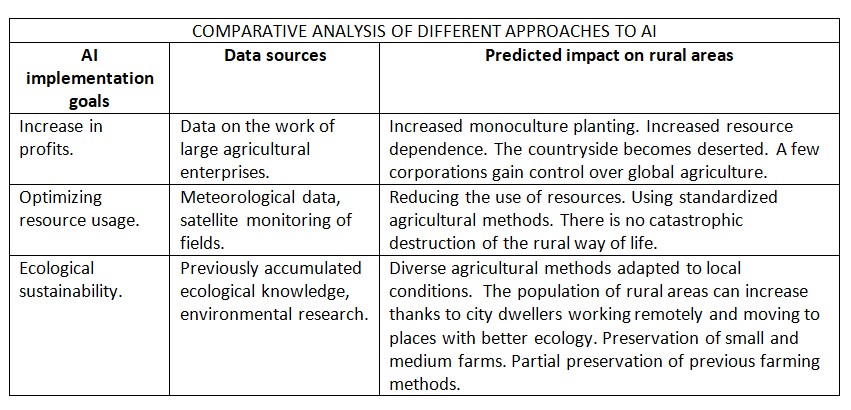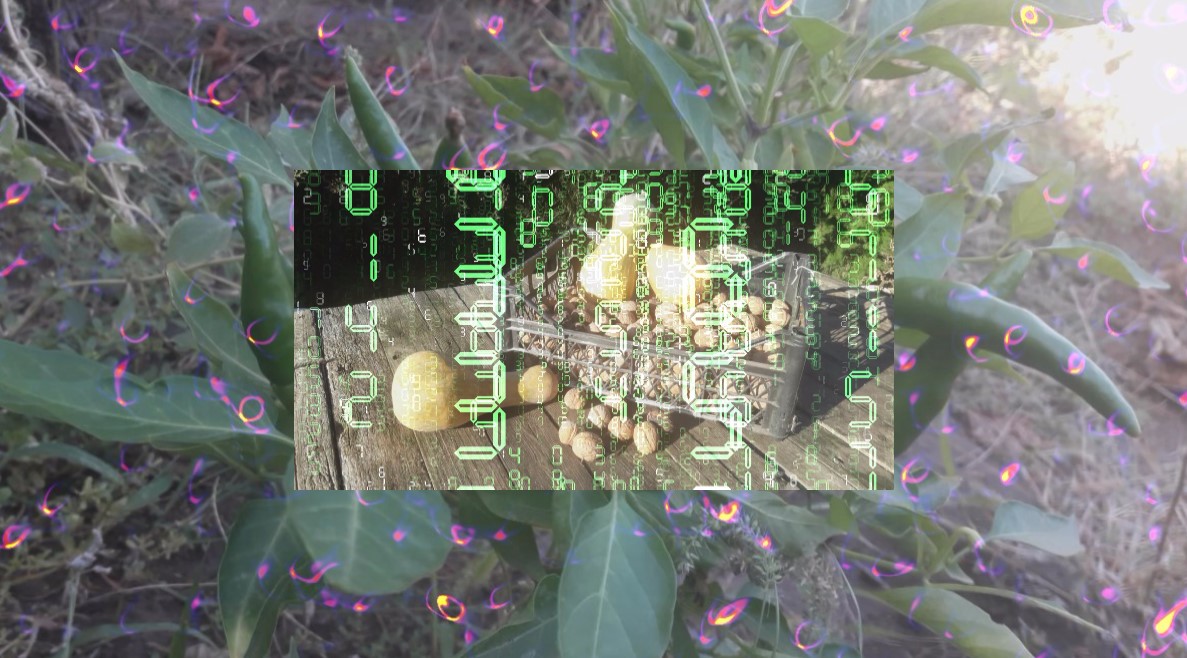
The most painful changes will be within ourselves.
To make sure this is not a useless test, rural voters will have to actively work with politicians.
Artificial Intelligence (AI) is part of the fourth industrial revolution.1 The previous three industrial revolutions turned rural life upside down and the fourth revolution will be no exception. The only difference will be in the scale and speed of change. From 1250 to 1900, the average wheat yield in the UK only tripled, from 8.71 to 26.69 bushels/acre.2 The yield growth of other agricultural crops has been about the same over the same period. But some AI projects suggest increasing agricultural crop yields by 15-20 per cent per year!3
Do you feel the dynamics of change? Of course, rural life will remain. But we are unlikely to recognise the village we are used to in a couple of decades. How can the village change?
Forecasts
The integration of AI into agriculture is more than just an increase in production efficiency. It is a socio-economic transformation of the entire rural life. Experts do not rule out any development of the situation from “very bad” to “very good” scenarios.4
In a negative development of the situation, rural communities will literally die out due to a catastrophic reduction in the labour market. Monoculture farming will intensify, the use of chemicals will increase, and the environment will deteriorate. Power will be concentrated in a small group of people. And a few giant corporations will become the basis of agriculture. This will increase the vulnerability of agriculture and reduce the diversity of product offerings, production methods, etc.
If the situation develops positively, the rural labour market will be improved. Many skilled jobs will be created and working conditions will improve. Regenerative agriculture will actively develop, environmental sustainability will improve and the human impact on the environment will be minimised. Food systems will be decentralised. Small farms and rural communities will receive greater rights and opportunities. Several scenarios for the implementation of AI in agriculture are presented in the figure.6 The consequences depend on the goals that people are trying to achieve.

Let’s be honest. The reality is likely to be somewhere in the middle. Rural communities will change. But it won’t be a boom or a bust. It will be a turbulent storm. The people who survive the storm will emerge stronger and more competitive.
The most painful changes will be the changes within us. We, the villagers, will have to experience the death and rebirth of our community.
Digitalisation of agriculture might destroy some people’s sense of self. Farmers could lose touch with the land. Because between them and the land there will be robots! Many farmers may lose the pleasure of their work because of this. This side effect of the introduction of AI is called “digital agriculture infection”.5
Rural residents may also lose their self-identification, weakening social ties and connections with nature. Many people might lose their sense of independence, identity and gain a sense of being under the control of external forces. The motivation to work and the sense of one’s own competence could decrease. Part of the cultural heritage will be lost. Even the now familiar skills of agricultural work may be forgotten. For many people, the loss of sources of income will become inevitable. And this could well create the preconditions for changing their place of residence.6
These are such unpleasant changes that in many countries rural communities might experience popular uprisings and destruction of private property. Something similar happened after the invention of the threshing machine in the 1820s. Then, farmers who lost their jobs burned their crops and farms.7 In the era of digitalisation of agriculture, it is robots and information systems that would be destroyed.
However, outbreaks of human impotence will not stop technical progress. And the reduction of the labour market will not be fatal. AI will not initiate, but will only accelerate, the global trend of reduction of agricultural workers. This process began even before the introduction of AI. From 2000 to 2022, the number of agricultural workers worldwide decreased by 177 million people, from 40 per cent to 27 per cent of the entire human labour force.8
People who survive all of the above may receive a pleasant part of the digitalisation of agriculture as a reward. Namely, quality education at the level of educational institutions in large cities. There are already many programs for distance learning for rural residents using AI. For example, Byju’s in India.9 Healthcare in rural areas could also become as good as in megacities. This might be achieved through special medical programs using AI. For example, the ubiquitous IBM Watson Health.10 Energy conservation and the level of public services might also improve.
Agriculture could become more sustainable. Many businessmen will earn money on digitalisation. The introduction of AI in various sectors of the economy could allow for income from US$2.6 trillion to US$4.4 trillion per year.11 In the global food production industry, the introduction of AI could create an economic effect of US$250 billion.12 Artificial intelligence could increase the agricultural GDP of low- and middle-income countries by US$450 billion or 27 per cent.13
Politicians will determine how well or badly the digitalisation of agriculture will go. These guys are already on the job.

What will the development of the situation depend upon?
Politicians are the natural intermediaries between farmers for whom AI is developed and the AI developers. This is because farmers cannot independently develop AI for their needs. For any state to function effectively, it is necessary to maintain a balance of interests for all parties to the transaction. This is what politicians are meant to do.
Australia was one of 30 countries that signed the “Bletchley Declaration on AI safety” in 2023.14 The final statement on the signing of the declaration states “the benefits of the technology can be harnessed responsibly for good and for all”. However, the real situation is very far from this.
The main problems at the tactical level are digital inequality and biased calculation algorithms. This deprives rural communities of the ability to control the situation. Here are two simple examples of how this happens in everyday life.
Android smartphones transmit 20 times more information about their owners to Google than iPhones transmit to Apple.15 This means that rural communities where Android smartphones are more common have lower data privacy than rural communities where iPhones are preferred.
Some developers of AI for agriculture directly admit to the dual purpose of software. These businessmen say that data collected by forecasting farm yields is transferred to banks and insurance companies. Financial institutions use data obtained to assess farm loans and insurance claims.16
Politicians need to pay attention to what is happening and pass laws that eradicate digital inequality bias in computing algorithms. This is in line with the policy of the Australian Government Department of Agriculture, Fisheries and Forestry. On one page of the department dedicated to AI it is stated that “DAFF will only utilise AI in accordance with applicable legislation, regulations, frameworks, and policies”.17
However, when we discuss the need to adopt necessary laws, it is important to understand that the main problem at strategic level is varying degrees of preparedness of national politicians to conclude a fair deal between farmers and AI developers.
In the UK18 and the USA, such institutes continue to be funded by governments. And this produces results. For example, in 2025, the United States Artificial Intelligence Institute published practical recommendations for the introduction of AI in rural communities.19 Here are these recommendations.
- Step 1: Needs Assessment. Identify the specific challenges the community faces. Engage local stakeholders to understand their priorities and tailor AI solutions accordingly.
- Step 2: Pilot projects. Start with small pilot projects to test feasibility and ensure the simplicity of the technology: user-friendly interfaces and support for local languages will make AI tools accessible. An example of a pilot project could be implementing an AI-powered educational app in one school or providing solar-powered devices to a farming community.
- Step 3: Engage with the community. Engage community leaders and influencers to build trust, support, and cultural fit. Use visual examples to explain the benefits of AI. For example, show how AI can predict rainfall. Help farmers plan their crops. Share success stories to inspire wider adoption by demonstrating tangible results, such as increased yields or improved learning outcomes, and build confidence.
- Step 4: Scale. After a successful pilot, scale the solution to other communities. To expand your reach, find partners among NGOs, government agencies, and tech companies.
The Australian government is taking a different path. In Australia, the government launched the AI Assurance Framework (AI Assurance Framework) in September 2024.20 This project aimed to test the safety of AI implementation, applicability and impact. Based on the findings of the pilot, DAFF is using the AI assurance framework to assess current AI use cases at different stages of the AI lifecycle.
As we can see, national governments act differently in the area of AI implementation in agriculture. No one knows which way will be the most effective.
Of course, studying the actions of politicians to regulate the introduction of AI in agriculture is the topic of a separate article. But the current situation shows that rural communities in different countries are not in an equal position for the advent of AI. So, in the current situation, the interest of rural voters in the activities of politicians in regulating the integration of AI into rural life is a key factor determining the future of rural communities. It all depends on you!
Conclusions
We will not be able to stop the AI era. And we will not be able to say exactly what future awaits us in the AI era. But we know for sure that the time-tested tactics of humanity will be effective this time too. We must remain strong and believe only in ourselves!
References
1. https://en.wikipedia.org/wiki/Fourth_Industrial_Revolution
2. https://en.wikipedia.org/wiki/British_Agricultural_Revolution
3. https://www.sciencedirect.com/science/article/pii/S2772375524000881
4. https://prism.sustainability-directory.com/scenario/ai-in-agriculture-labor-and-job-displacement/
5. https://rural.struttandparker.com/article/how-could-ai-change-life-in-the-rural-sector/
6. https://lifestyle.sustainability-directory.com/question/how-does-ai-impact-traditional-rural-lifestyles/
7. https://www.nationalarchives.gov.uk/education/resources/what-caused-the-swing-riots-in-the-1830s/
8. https://www.emerald.com/bfj/article/125/13/436/33857/Artificial-intelligence-and-new-business-models-in
9. https://byjus.com/
10. https://www.ibm.com/watson
11. https://www.mckinsey.com/capabilities/mckinsey-digital/our-insights/the-economic-potential-of-generative-ai-the-next-productivity-frontier#key-insights
12. https://www.mckinsey.com/industries/agriculture/our-insights/from-bytes-to-bushels-how-gen-ai-can-shape-the-future-of-agriculture
13. https://static1.squarespace.com/static/61f723d2d47f140c4200a1d9/t/65557be9c2f23404d1576704/1700101355494/State+of+the+Digital+Agriculture+Sector+in+LMICS+-+Whole+Report.pdf
14. https://www.gov.uk/government/publications/ai-safety-summit-2023-the-bletchley-declaration/the-bletchley-declaration-by-countries-attending-the-ai-safety-summit-1-2-november-2023
15. https://link.springer.com/chapter/10.1007/978-3-030-90022-9_12
16. https://www.youris.com/bioeconomy/agriculture/betting-on-technology-to-repopulate-rural-areas-when-ai-meets-agriculture-and-sustainability.kl
17. https://www.agriculture.gov.au/about/reporting/obligations/AI-transparency-statement
18. https://www.gov.uk/government/publications/ai-safety-institute-overview/introducing-the-ai-safety-institute
19. https://www.usaii.org/ai-insights/bridging-the-digital-divide-leveraging-ai-for-inclusive-transformation-in-rural-communities
20. https://www.digital.gov.au/policy/ai/pilot-ai-assurance-framework
